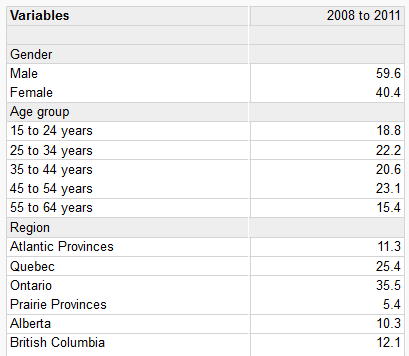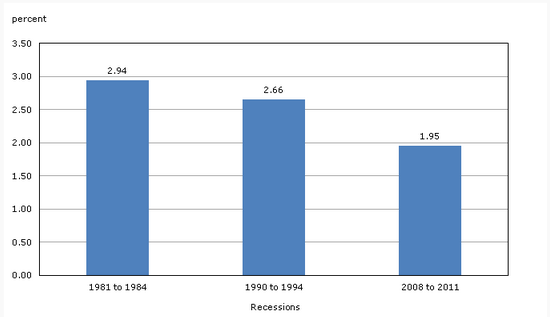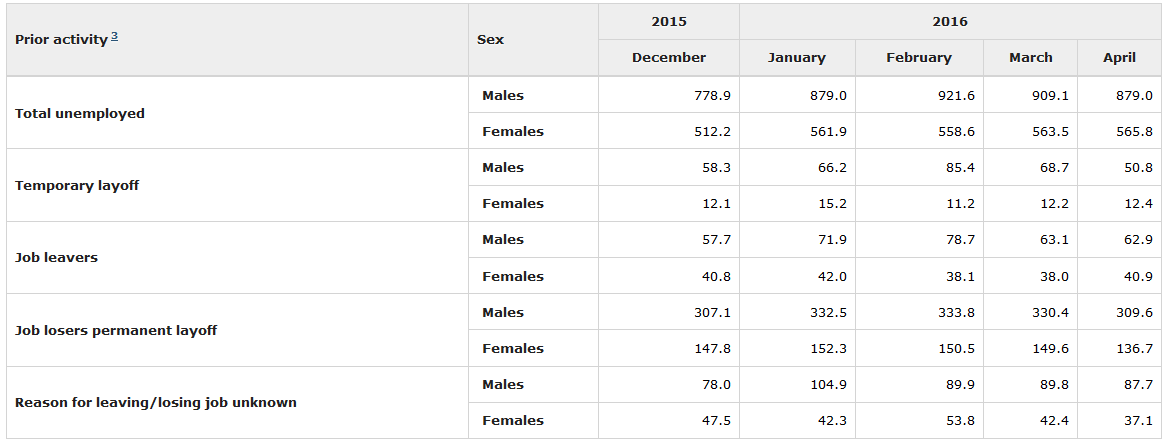Abstract
The paper discusses the problem of downsizing in Canadian organizations. Downsizing is a practice that is used by managers as a response to the economic crisis, reductions in funding, and other negative conditions. In Canada, three recession periods were observed, and they led to an increase in rates of corporate downsizing. The problem is in determining approaches to surviving the downsizing in a corporate context. Thus, the paper is focused on exploring the phenomenon of downsizing and identifying strategies related to surviving the downsizing problem. The method utilized in this descriptive research is the analysis of statistical data related to layoff rates during recessions. The analysis indicates that downsizing is typical of Canadian public service companies, as well as firms working in primary and construction industries. Tendencies of surviving demonstrate that middle-aged employees and managers are rarely fired. Furthermore, leaders are inclined to choose new downsizing procedures rather than terminations.
Downsizing is a process when the structure of a company can be re-organized, and procedures can be modified, leading to layoffs and other organizational changes. Therefore, according to Datta et al. (2010, p. 282), downsizing can be viewed as the “planned set of organizational policies and practices aimed at workforce reduction to improve firm performance.” Corporate downsizing is typical of many developed countries because this practice is perceived as effective to address negative economic changes during crises and periods of recession. The problem is in the fact that in Canada, the period of 2008-2011 was characterized by a significant economic recession, and many companies chose the downsizing approach as a strategy to
reduce costs and improve the performance while selecting the lower number of employees (Government of Canada 2015). From this perspective, the important questions to discuss are what features are characteristic of corporate downsizing in Canada and how companies can address the issue of ‘surviving’ the consequences of downsizing. The purpose of this paper is to examine the downsizing phenomenon in the context of the Canadian organizations and focus on approaches to surviving the downsizing problem.
Literature Review
Corporate downsizing is a strategy that is followed by the employer when it is necessary to reduce costs associated with retaining the workforce, as well as operational costs (Goesaert, Heinz & Vanormelingen 2015). According to Kalev (2014), employers choose to downsize because they evaluate costs associated with supporting human resources as high, and they propose the optimization procedures and practices to increase productivity. Still, there are several approaches to downsizing, and companies can choose to change the work process, apply new approaches, reduce the personnel, refer to outsourcing, or hire only temporary employees (Luan, Tien & Chi 2013; Scott et al. 2011). Goldman (2011) pays attention to the fact that in many cases, downsizing is a problem associated with the ineffective leadership when reductions in the workforces are discussed as the only method to address economic pressures. Thus, both external and internal factors are important to influence layoffs in companies.
In their turn, Munoz‐Bullon and Sanchez‐Bueno (2010) also note that downsizing is observed when economic pressures make organizations find new ways of becoming more profitable. McDevitt, Giapponi, and Houston (2013) state that the highest levels of downsizing can be noticed in organizations during crises and recessions because employers try to use each opportunity to reduce costs and increase profits. Nevertheless, opponents of the downsizing initiatives state that positive effects of these strategies are usually short-term because of the pressure of the ‘surviving’ issue (Van Dierendonck & Jacobs 2012). Thus, the primary goal of the organization that chooses the downsizing approach is to survive under the impact of disadvantageous economic conditions (Datta et al. 2010; Munoz‐Bullon & Sanchez‐Bueno 2014). However, Levitt, Wilson, and Gilligan (2008), as well as Lahner et al. (2014), found that those employees who were not fired because of corporate downsizing could suffer from the ‘survivor syndrome’. These employees are usually unmotivated to work effectively, the effectiveness of their performance can decrease, and they can demonstrate the fear of being fired.
In Canada, corporate downsizing is perceived as an appropriate strategy to address economic issues. Thus, the Government of Canada proposed the Work Force Reduction Program, the purpose of which is to reduce the number of employees in organizations while providing them with compensation packages and benefits (Work Force Reduction program due to downsizing 2016). The Canadian employers also refer to the practice of downsizing as an approach to increasing the profitability of the company (Chhinzer 2014; Mentzer 2009). However, Lakshman et al. (2014) state that in most cases, it is possible to observe the opposite results because employees are inclined to perceive companies which use downsizing procedures negatively and their productivity can decrease. Downsizing can be associated with the low potential of the company to guarantee the financial stability and support employees in critical situations.
Methods
In order to examine the downsizing phenomenon in Canada during the recent years and with the focus on recessions and surviving tendencies in companies, it was necessary to utilize the quantitative methodology. The descriptive study and analysis were selected as the main method because of the necessity to evaluate the numerical and statistical data retrieved from Statistics Canada, the online database that provides results of national surveys (Government of Canada 2015; Government of Canada 2016). In order to answer the research questions and address the purpose of the study, it was necessary to collect the statistical data on characteristics of employees fired because of downsizing strategies during the recent recession period (2008-2011). In addition, it was necessary to gather the data regarding layoff rates during recession periods associated with downsizing. Finally, the number of persons fired because of downsizing or associated causes in the late part of 2015 and the early part of 2016 was also examined. The descriptive analysis of these data is important to provide the conclusion regarding tendencies of downsizing in Canada and their effects on the population influenced by the practice or surviving it.
Data Analysis
The data on characteristics of employees who were laid-off during the recent recession period (2008-2011) were selected for the analysis in order to determine features of downsizing in the context of gender, age, region, industry, and occupation. Table 1 presents the information regarding gender, age, and the location of workers who were laid-off in 2008-2011.


During the period of 2008-2011, about 60% of male employees were laid-off in comparison to 40% of females. Over 23% of 45-54-year-old employees became victims of downsizing in comparison to other age groups. In addition, the downsizing tendencies led to firing more than 22% of 25-34-year-old employees who represent the majority of the workforce in Canada. The highest layoff rates were observed in Ontario (35.5%), where many big and small companies chose downsizing in 2008-2011 (Government of Canada 2015). These data indicate that downsizing during the recession period mostly affected 25-34-year-old and 45-54-year-old male employees, and the most problematic situation was observed in Ontario. Table 2 presents the data regarding differences in industries and the occupation of fired employees.
The highest percentage of layoffs was observed in the primary and construction industries (about 23%). The number of the fired employees was also high in public service companies (19.5%) because, in these companies, downsizing is a usual practice. As a result, the clerical staff, service staff, and sales staff were fired in the first place. On the contrary, it is possible to note that downsizing tendencies usually do not affect persons taking managerial positions because only about 3% of managers were fired in 2008-2011. These results support the idea that public services and construction companies, as well as employees taking the lowest positions, suffer from downsizing directly when companies from other industries and employees taking high managerial positions usually survive downsizing.
Figure 1 provides the comparison of layoff rates typical of three recession periods in Canada which were characterized by intensive corporate downsizing.

In 1981-1984, the layoff rate was the highest one, and in 2008-2011, it was minimal (2.94% and 1.95% accordingly) while comparing three recession periods. Therefore, it is possible to state that corporate downsizing had less negative effects on the workforce employment than they were in the 1980s and 1990s.
Table 3 presents results of the workforce survey indicating employees’ activities prior to the unemployment that can be associated with downsizing and other causes during the late part of 2015 and the early part of 2016.

According to Table 3, the permanent layoff associated with downsizing was typical of about 300,000-330,000 male Canadians during the period of December 2015-April 2016. For females, the numbers are lower. Thus, about 135,000-152,000 female Canadians were fired in December 2015-April 2016 because of causes associated with downsizing. The number of fired males is twice as large as the number of laid-off females. This aspect can be explained with references to the fact that companies that choose the downsizing strategies usually employ more male workers, as it is in construction and manufacturing industries.
Discussion
Researchers note that periods of economic crises and recession influence the development of downsizing initiatives (Chhinzer & Currie 2014; Cohen, Coval & Malloy 2011; Datta et al. 2010). The analysis of the data indicates that downsizing tendencies in 2008-2011 mostly affected middle-aged employees when young employees had an opportunity to survive downsizing. Furthermore, managers also had more perspectives and chances to survive in this situation. According to Goldman (2011), downsizing is a strategy that is used by employers in order to reduce the workforce and achieve the high-level productivity, as well as the improved performance with references to lower costs. Therefore, corporate downsizing affects sales and temporary positions more actively than positions of managers. The data regarding age differences of laid-off employees can be explained with the focus on the fact that the percentage of 15-24-year-old workers in the Canadian companies is not as high as the percentage of 25-44-year-old employees.
In spite of the fact that corporate downsizing is typical of recession periods, the study results demonstrate that layoff rates are the lowest ones for the latest recession period in Canada. According to Scott et al. (2011), many organizations choose downsizing strategies that are more flexible than previously, and they allow avoiding significant reductions in the workforce. Thus, the Canadian organizations can downsize with references to re-organizing the working processes rather than firing employees (Chhinzer 2014). As a result, the percentage of surviving companies and workers increases.
It is important to note that in Canada, the downsizing practices are characterized by such features as the focus on retaining young and qualified employees. From this point, the process of surviving the downsizing issue can be discussed with references to employees’ opportunities to preserve the status and position in the company, as well as with references to employees’ wider responsibilities and duties. However, in comparison to the other causes leading to the unemployment in Canada, layoffs associated with downsizing are the most frequent ones. The study results indicate that the problem is most urgent for males. Chhinzer (2014) states that, in Canada, males represent the majority of the workforce, and this aspect can explain why men are fired most often while comparing the data for women and men for the same period. From this point, downsizing remains to be a problem in the sphere of human resource management, and it requires the effective solution.
Conclusion
The data analysis indicates that, in the Canadian organizations, corporate downsizing can be observed during the recession period. Furthermore, the organizations that tend to use the downsizing initiatives are public services companies and firms that represent primary and construction industries. It is also necessary to state that employees who are laid-off more frequently usually take the lowest positions in companies. The statistics demonstrate that the majority of the fired staff is males. However, currently, the Canadian companies use such downsizing strategies as the application of new working processes and outsourcing. They are used in order to provide more employees with opportunities to survive the downsizing practice and remain employed. As a result, overall layoff rates tend to decrease for Canada in spite of the further use of downsizing procedures.
Reference List
Chhinzer, N 2014, ‘The role of reasonable notice legislation in organizational downsizing decisions in Canada’, International Journal of Law and Management, vol. 56, no. 5, pp. 387-392.
Chhinzer, N & Currie, E 2014, ‘Assessing longitudinal relationships between financial performance and downsizing’, Management Decision, vol. 52, no. 8, pp. 1474-1490.
Cohen, L, Coval, J & Malloy, C 2011, ‘Do powerful politicians cause corporate downsizing?’, Journal of Political Economy, vol. 119, no. 6, pp. 1015-1060.
Datta, D, Guthrie, J, Basuil, D & Pandey, A 2010, ‘Causes and effects of employee downsizing: a review and synthesis’, Journal of Management, vol. 36, no. 1, pp. 281-348.
Goesaert, T, Heinz, M & Vanormelingen, S 2015, ‘Downsizing and firm performance: evidence from German firm data’, Industrial and Corporate Change, vol. 24, no. 6, pp. 1443-1472.
Goldman, A 2011, ‘Demagogue to dialogue: an alternative to toxic leadership in corporate downsizings’, Organizational Dynamics, vol. 40, no. 3, pp. 235-240.
Government of Canada 2015, Workers laid-off during the last three recessions: who were they, and how did they fare?, Web.
Government of Canada 2016, Statistics Canada: labor force survey estimates (LFS), activity prior to unemployment by sex and age group, Web.
Kalev, A 2014, ‘How you downsize is who you downsize biased formalization, accountability, and managerial diversity’, American Sociological Review, vol. 79, no. 1, pp. 109-135.
Lahner, J, Hayslip, B, McKelvy, T & Caballero, D 2014, ‘Employee age and reactions to downsizing’, The International Journal of Aging and Human Development, vol. 79, no. 3, pp. 225-255.
Lakshman, C, Ramaswami, A, Alas, R, Kabongo, J & Pandian, J 2014, ‘Ethics trumps culture? A cross-national study of business leader responsibility for downsizing and CSR perceptions’, Journal of Business Ethics, vol. 125, no. 1, pp. 101-119.
Levitt, K, Wilson, T & Gilligan, E 2008, ‘Corporate downsizing: an examination of the survivors’, Journal of Global Business Issues, vol. 2, no. 2, pp. 13-19.
Luan, C, Tien, C & Chi, Y 2013, ‘Downsizing to the wrong size? A study of the impact of downsizing on firm performance during an economic downturn’, International Journal of Human Resource Management, vol. 24, no. 7, pp. 1519-1535.
McDevitt, R, Giapponi, C & Houston, D 2013, ‘Organizational downsizing during an economic crisis: survivors’ and victims’ perspectives’, Organization Management Journal, vol. 10, no. 4, pp. 227-239.
Mentzer, M 2009, ‘Corporate downsizing and profitability in Canada’, Canadian Journal of Administrative Sciences, vol. 13, no. 3, pp. 237-250.
Munoz‐Bullon, F & Sanchez‐Bueno, M 2010, ‘Downsizing implementation and financial performance’, Management Decision, vol. 48, no. 8, pp. 1181-1197.
Munoz‐Bullon, F & Sanchez‐Bueno, M 2014, ‘Institutional determinants of downsizing’, Human Resource Management Journal, vol. 24, no. 1, pp. 111-128.
Scott, B, Ueng, J, Ramaswamy, V & Chang, C 2011, ‘Layoff and firm long-term performance’, Academy of Strategic Management Journal, vol. 10, no. 2, pp. 1-10.
Van Dierendonck, D & Jacobs, G 2012, ‘Survivors and victims, a meta‐analytical review of fairness and organizational commitment after downsizing’, British Journal of Management, vol. 23, no. 1, pp. 96-109.
Work Force Reduction program due to downsizing 2016, Web.